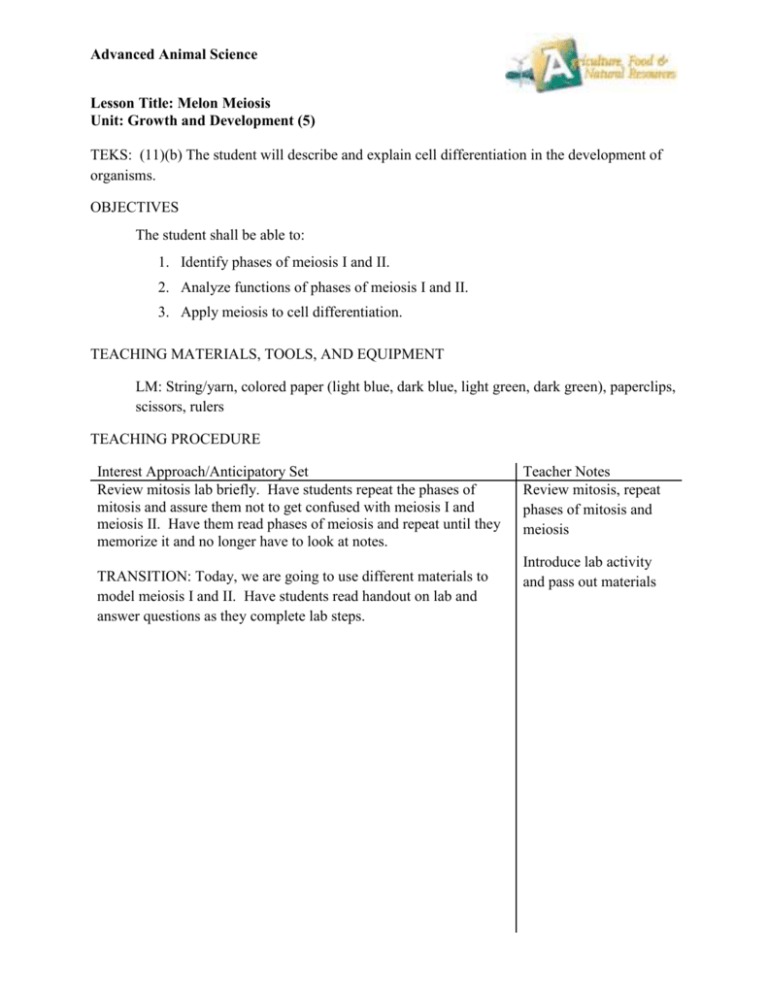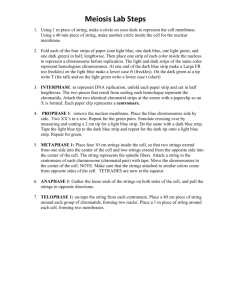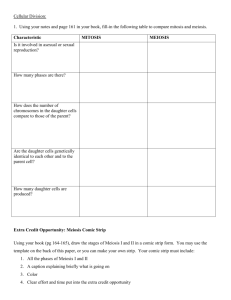Advanced Animal Science Lesson Title: Melon Meiosis Unit: Growth
advertisement

Advanced Animal Science Lesson Title: Melon Meiosis Unit: Growth and Development (5) TEKS: (11)(b) The student will describe and explain cell differentiation in the development of organisms. OBJECTIVES The student shall be able to: 1. Identify phases of meiosis I and II. 2. Analyze functions of phases of meiosis I and II. 3. Apply meiosis to cell differentiation. TEACHING MATERIALS, TOOLS, AND EQUIPMENT LM: String/yarn, colored paper (light blue, dark blue, light green, dark green), paperclips, scissors, rulers TEACHING PROCEDURE Interest Approach/Anticipatory Set Review mitosis lab briefly. Have students repeat the phases of mitosis and assure them not to get confused with meiosis I and meiosis II. Have them read phases of meiosis and repeat until they memorize it and no longer have to look at notes. TRANSITION: Today, we are going to use different materials to model meiosis I and II. Have students read handout on lab and answer questions as they complete lab steps. Teacher Notes Review mitosis, repeat phases of mitosis and meiosis Introduce lab activity and pass out materials Advanced Animal Science Teaching Plan and Strategy / Presentation of New Material Teacher Notes Procedure: Demonstrate steps 1. Using 1 m piece of string, make a circle on your desk to represent the cell membrane. Using a 40 mm piece of string, make another circle inside the cell for the nuclear Help students membrane. 2. Fold each of the four strips of paper (one light blue, one dark blue, one light green, and one dark green) in half, lengthwise. Then place one strip of each color inside the nucleus to represent a chromosome before replication. The light and dark strips of the same color represent homologous chromosomes. At one end of the dark blue strip make a Large FR (no freckles) on the light blue make a lower case fr (freckles). On the dark green at a tip write T (for tall) and on the light green write a lower case t (short) 3. INTERPHASE: to represent DNA replication, unfold each paper strip and cut in half lengthwise. The two pieces that result from cutting each homologue represent the chromatids. Attach the two identical chromatid strips at the center with a paperclip so an X is formed. Each paper clip represents a centromere. 4. PROPHASE 1: remove the nuclear membrane. Place the blue chromosomes side by side. Two XX’s in a row. Repeat for the green pairs. Simulate crossing over by measuring and cutting a 2 cm tip for a light blue strip. Do the same with a dark blue strip. Tape the light blue tip to the dark blue strip and repeat for the dark tip onto a light blue strip. Repeat for green. 5. METAPHASE 1: Place four 10 cm strings inside the cell, so that two strings extend from one side into the center of the cell and two strings extend from the opposite side into the center of the cell. The string represents the spindle fibers. Attach a string to the centromere of each chromosome (chromatid pair) with tape. Move the chromosomes to the center of the cell. NOTE: Make sure that the strings attached to similar colors come from opposite sides of the cell. TETRADES are now at the equator. 6. ANAPHASE 1: Gather the loose ends of the strings on both sides of the cell, and pull the strings in opposite directions. 7. TELOPHASE 1: un-tape the string from each centromere. Place a 40 cm piece of string around each group of chromatids, forming two nuclei. Place a 1 m piece of string around each cell, forming two membranes. Advanced Animal Science MEIOSIS 2 1. PROPHASE 2: Remove the strings that represent the nuclear membrane and the cell membranes in both cells. Attach a 10 cm piece of string to each chromatid. 8. METAPHASE 2: Move the chromosomes to the center of each cell. Make sure the strings attached to the two strips in each chromosome come from opposite sides of the cell. 9. ANAPHASE 2: Gather the strings on both sides of each cell, and pull the strings in opposite directions, separating the paper strips. Note: Only one strip in each pair will have a paper clip attached. 10. TELOPHASE 2: Untape the strings. Remove the strings and paper clips. Each strip of paper now represents a chromosome. Place a 40-cm. piece of string around each group of chromosomes, forming four nuclei. Place a 1m string around each cell, forming four membranes. Assure all groups completed and all questions answered. Go over questions as a class and review. ENGAGEMENT Students are engaged by being in groups and being able to interact with one another to perform the given task: model meiosis using materials given. They are able to use their own creativity to a certain extent but must follow the steps on the handout given. They are able to answer their lab questions as a group. EVALUATION Evaluation will take place throughout the lesson as the teacher walks around to help students model meiosis. At the end of the lesson, the teacher will go over questions on the lab handout with the class and review the steps of meiosis and how it relates to cell differentiation. ADDITIONAL MATERIALS Handout: www.nclark.net/ModelingMeiosislab.doc ©Texas Education Agency, 2011







